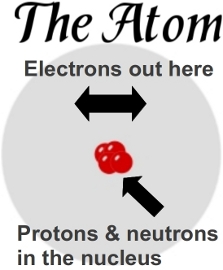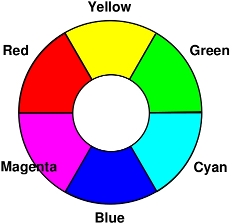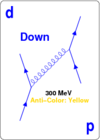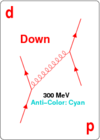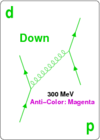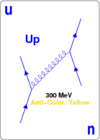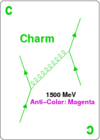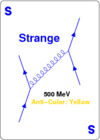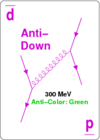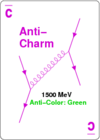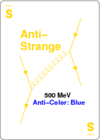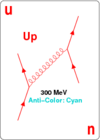Introduction
QCD is a game based on the rules of how quarks combine to form particles of matter and
anti-matter. Quarks make up the protons and neutrons found in the nucleus of every atom.
Other quark combinations give rise to exotic particles with
strangeness and
charm.
Quarks are different from the electrons that circulate outside the nucleus because they
have
two kinds of charge. Both electrons and quarks have
electric charge,
so they both can feel the electric force. But quarks alone have
color charge, so
they can feel the nuclear force that holds the nucleus together. Color charge is not the
same as visible color, but the idea of color helps describe how quarks combine.
Quarks come in a variety of flavors. The QCD deck includes
up, down, strange
and
charm and their anti-quark partners. Wild cards, representing particles
known as the
vector bosons, transmit the so-called
weak force, and can
transmute quarks from one flavor to another as described below. The value of a quark
card depends on its flavor, and is equal to the energy it contributes to a particle.
Each quark has one of the three primary colors (red,green or blue) while the
anti-quarks each have one of the anti-colors (cyan, magenta or yellow).
Rules for several card games that can be played with a QCD deck are given below.
In each game you will form card sets that represent
the particles found in nature. The rule for forming a card set is the same rule quarks
follow when combining to form a real particle: Every particle must be
color neutral,
meaning that the colors all cancel out. One way to do that is to combine three quarks,
one of each color. Particles containing three quarks are known as baryons. Protons and
neutrons are examples of baryons, but any particle with three different-colored quarks
is a baryon. Another possibility is to combine three anti-quarks, each of a different
anti-color, to form an anti-baryon. Finally, particles known as mesons consist of a
quark/anti-quark pair, where the quark's and anti-quark's colors are opposite each other
on the color wheel. See below for examples of baryons, anti-baryons and mesons.
Most particles are unstable, and disintegrate within a small fraction of a second in
a process called radioactive decay. You may have heard about what happens when
matter and antimatter come in contact. KABOOM!! All of the energy is released,
mostly as gamma radiation. This is known as matter-antimatter annihilation.
See below for examples of how to use disintegration and anihilation to score points.
Color Neutrality
The rule for combining quarks is that all the colors must cancel out.
Just as equal parts of red, green and blue combine to form white on a
computer monitor, so too a red quark, a green quark and a blue quark
combine to form a colorless, or
color-neutral particle called a
baryon. Likewise, a cyan, a magenta and a yellow anti-quark will
combine to form a color-neutral anti-baryon. The colors also cancel out
if you combine a quark with an anti-quark having the opposite color.
This type of particle is called a
meson. Examples off all three
particle types are shown below.
Baryon Examples
Baryons contain three quarks, each with a different primary color.
It does not make any difference which quark has which color, as long
as all three are different. There are many types of baryons including
protons and neutrons. Use the scroll bar to the right to see a few
examples of Baryons.
Anti-Baryon Examples
Anti-Baryons contain three anti-quarks, each with a different color.
It does not make any difference which anti-quark has which color, as
long as all three are different. Every baryon has an associated anti-baryon.
Use the scroll bar to the right to see a few examples of Anti-Baryons.
A Pion

Another Pion
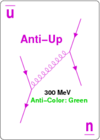
And Another Pion
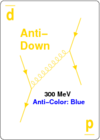
And Another

Real pions are a combination of these two types.
A Kaon

Another Kaon
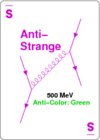
Charmed Meson
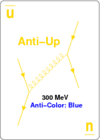
Strangeness and Charm

Meson Examples
Mesons consist of a quark/anti-quark pair where the quark and anti-quark
have opposite colors. Cyan is the opposite of red, magenta is the opposite
of green, and yellow is the opposite of blue. Use the scroll bar to the
right to see a few examples of Mesons.
Matter-Antimatter Annihilation
Matter-antimatter annihilation is both an offensive and defensive play in QCD. It allows you to
capture an opponent's particle energy, while simultaneously protecting your own particles.
When two particles annihilate, every quark in one particle must have its anti-quark present
in the other. In the exaple to the right, a prton annihilates with an anti-proton. The arrows
indicate the matching between the quarks and the anti-quarks. Each up quark matches with an
anti-up, and the down-quark matches with an anti-down. Notice that the colors do
NOT
need to match. In the example, the color of the anti-down is cyan rather than yellow. Yet
the cyan anti-down may still annihilate with the blue down quark, even though the colors are
not opposite.
As a second example, consider annihilation between two pions, as shown to the left. a pion is
a type of meson that contains only up and/or down quarks.
(See the
meson examples above for more examples of pions.) Like all
mesons, a pion contains one quark and one anti-quark where the anti-quark color is the opposite
of the quark color. In the example, the first pion is composed of an up quark paired with an
anti-down quark. It annihilates with a second pion composed of a down quark paired with an
anti-up quark. Each quark in one pion finds it's anti-quark partner in the other pion, so the
two particles may annihilate one another.
Notice again that the colors do not have to be opposites for two quarks to annihilate.
When a player annihilates a baryon with an anti-baryon, all six cards are added to his
energy stack and contribute to his score. Likewise, all four cards contribute to the
score in an annihilation between charmed mesons (mesons containg charm or anti-charm quarks).
But some special rules apply to other types of mesons.
Annihilating Pions
When two pions annihilate, as in the example above, only one of the quark cards are placed
in the energy stack. The other three go in a dead-card pile and are not considered in
the score.
Annihilating Kaons
Kaons are mesons that contain a strange or anti-strange quark, but no charm.
(See the meson examples above for examples of kaons.)
When two kaons annihilate one another, the strange and anti-strange quark cards are placed in
the energy stack. The remaining two up/down/anti-up or anti-down cards go in the dead-card pile.
Possible Transmutations
| c → s
| s → u
| u → d
| d → u
|
|
c →
s
|
s →
u
|
u →
d
|
d →
u
|
Wild Cards: The Intermediate Vector Boson
The
w card represents the intermediate vector boson,
or
vector boson for short. This particle transmits the
weak
interaction causing quarks to change from one flavor to another. This is
called
transmutation, and can be extremely useful when attempting to
annihilate particles. As shown in the table to the right, the
w can
change charm to strange, strange to up, up to down, and down to up. The
equivalent transmutations also apply to the anti-quarks. The
w can
not, however, convert a quark to an anti-quark or vice-versa.
Using the w increases your score by allowing you to annihilate particles
that you could not annihilate otherwise. There is a slight cost, however,
in that the energy of the quark that was transmuted will not add to your score.
The transmuted quark (along with the w are instead placed in the
dead-card pile. When annihilating pions or kaons, some of the up and down
quarks already are headed for the dead-card pile. If the final flavor of the
transmuted quark is up or down, you may use the tranmuted quark as one of those
dead cards. In that case, there is no extra penalty for using the w.
Example use of Vector Boson
An example of how to use the w card is shown to the right.
The top card set represents a neutron (u, d, d) while the bottom card
set represents an anti-proton
(u,
d,
u).
Normally, these particles can not annihilate each other because only
two of the three quarks in the neutron find their anti-quark counterpart
in the anti-proton. Applying the w to one of the down quarks in
the neutron set transmutes the down to an up, allowing it to match up with
one of the anti-up quarks in the anti-proton set. The two particles are
thus able to annihilate each other thanks to the w. The transmuted
down quark is placed in the dead-card pile, and the player scores with the
remaining five cards, which are added to his energy stack.
Disintegration (Radioactive Decay)
Except for the proton and neutron, every baryon, anti-baryon amd meson is
unstable, disintegrating within a small fraction of a second of being formed.
Even the neutron is slightly unstable, disintegrating within about 15 minutes
unless it is inside an atomic nucleus. Disintegration, also called
radioactive decay, is another way for you to claim credit for your card
sets. To disintegrate a particle, a player simply places the cards face down
in his energy stack.
When playing Accelerator, all particle except for pions are
disintegrated as soon as they are formed. In Quark Rummy, except
in a few special cases described below, a player must wait one turn before
disintegrating particles after they are played. This allows other players an
opportunity to capture the energy through annihilation. If one forgets to
disintegrate a particle before laying down a new card set, the opportunity to
disintegrate a particle on that turn has been missed. This reflects the fact
that radioactive decay is a random process. A given particle is not guaranteed
to decay at any specific time.
Special Rule for Pions
Pions, which are light mesons made up of only up, anti-up, down, and anti-down
quarks, may never be disintegrated during the game. The energy for a
pion is only added to the score when they annihilate with another pion.
(See the meson examples above for examples pions.)
Special Rule for Nucleons (Protons and Neutrons)
Protons (u, u, d) and neutrons (d, d, u) and their anti-matter counterparts are
stable, and so may not be disintegrated until the end of the hand. This
particular rule applies only to Quark Rummy. When playing
Accelerator, protons and neutrons are added to the energy stack as
soon as they are formed.
Special Rule for Deltas
Delta particles (u, u, u or d, d, d) are about ten-billion times more unstable
than most other particles, and so may be disintegrated as soon as they are played,
without waiting until the next turn.
Disintegration of Kaons
Kaons are a type of meson that contain a strange or anti-strange quark, combined
with an up, down, anti-up, or anti-down quark.
(See the meson examples above for examples kaons.)
The rule for disintegrating a kaon is similar to that for annihilating two kaons.
Only the strange or anti-strange quark is to be added to the player's energy stack.
The up, down or anti-up or anti-down quark goes in the dead-card pile and is not
considered in the score.
| Quark | Energy
|
|---|
| Up, Anti-Up | 300 MeV
|
| Down, Anti-Down | 300 MeV
|
| Strange, Anti-Strange | 500 MeV
|
| Charm, Anti-Charm | 1500 MeV
|
Score Keeping
Score is kept in terms of particle energies, measured in
Mega Electronvolts (MeV).
Since particles have
mass, they also have
energy according to Einstein's
formula:
E=mc2. The energy of a particle
is added to a player's score when the particle disintegrates or annihilates with another
particle. In QCD-The Game, a fixed energy is assigned to each quark card as in the table
to the right. You should think of these values as the amount of energy the quark contributes
to baryons, anti-baryons and mesons, rather than the energy contained by the quark itself.
The special rules for pions and kaons keep the energy awarded for each colorless particle
to within a few percent of the value found in nature. Real pions contain only about 150 MeV,
so in
Quark Rummy and
Accelerator pions may not be disintegrated. When they
annihilate, only one up or down quark is placed in the energy stack, so the total energy
awarded for two pions is 300 MeV. Real Kaons contain 500 MeV, so when they disintegrate
or are annihilated during game play, only the strange quark counts toward the score.
Quark Poker (2 to 7 players)
The rules are the same as ordinary poker, except the ranking of hands is as follows:
- Pentaquark (a baryon or anti-baryon, plus a meson)
- Baryon or anti-baryon (equal value)
- Two mesons
- Meson
- High card
When two or more players have hands of the same rank, the total energy of the hand is the
deciding factor. Two W cards may be kept in the deck as wild cards.
Quark Rummy (2 to 4 players)
Shuffle the cards and deal five cards to each player in a clock-wise fashion.
The remaining cards are placed in a stack, face down, and the top card placed
face up beside it. This will become the discard pile. The player to the dealer's
left takes the first turn, followed by the player to his left and so on. The
responsibility of dealing will also advance clockwise around the table. On each
turn, players will perform the following tasks, in order:
- Draw one quark card from the draw stack, or take the top card from the discard pile.
- Disintegrate one unstable particle that was played on a previous turn (see rules below).
Cards from a disintegrated particle are placed face down in a stack in front of the player.
This is referred to as the energy stack, and contributes to the player's score at the end
of the hand.
- Try to form new particles, observing the rule that particles must be color neutral.
If a player can form a particle, he must do so on his turn and lay the card set face up
in front of him.
- Attempt to annihilate as many of his particles as possible with any of his own or
his opponent's particles (see rules below).
- Draw cards from the draw stack to maintain 5 cards in his hand. If a player was
unable to form a particle on his turn, he must discard one card, face up, onto the
discard pile. Otherwise, a new card is turned up if the discard pile is empty.
If a player forgets to draw a card prior to making any other play, he may not draw a
card on that turn. If a player forgets to disintegrate a particle before performing
any of steps 3, 4 or 5, he must wait until his next turn to disintegrate a particle.
When the draw stack is exhausted, each player takes one additional turn, optionally
drawing the top card from the discard pile, and making whatever plays are possible
before passing to the next player. Finally, each player disintegrates all of his
remaining particles, including protons and neutrons, as explained in the Disintegration
section below. Players then sum the energy of all cards in their energy stacks,
subtract the value of cards remaining in their hands, and report the results to the
score keeper. The winner is the first player to accumulate 10,000 MeV, or the player
with the most energy if two or more players reach 10,000 MeV on the same hand. Players
may agree to play to a different energy total for a longer or shorter game.
Accelerator (3 to 6 players)
With 3, 5 or 6 players, 1, 2 or 4 cards, respectively, are placed face down in the
dead-card pile. All remaining cards are dealt. The player to the dealer's left leads by
playing any quark or anti-quark. If he plays a quark, the next player may play either
a quark of a different color, or an anti-quark with the opposite color. Likewise, an
anti-quark may be followed by another anti-quark of a different color, or a quark
with the opposite color. If two quarks or two anti-quarks have been played, the third
player tries to complete the baryon or anti-baryon by playing a card with the remaining color.
A player completing any baryon or anti-baryon, or a meson with strangeness or charm,
immediately places those cards in his energy stack and leads a new card. For kaons, only
the strange quark is placed in the energy stack, with the up or down quark going to the
dead-card pile. For pions, play continues with the remaining players attempting to form
a second pion to annihilate the first, using W cards as needed. The player who succeeds
places one up or down in his energy stack and leads a new card.
A player may pass on his turn only if he cannot make a valid play. If every player has
had a turn, and no complete particles were formed, or if no second pion was formed to
annihilate the first pion, the player who led has one last chance to complete the particle
and score energy points. If he cannot do so, all card that were in play are placed in
the dead-card pile, and he leads a new card. The hand ends following the round when any
player runs out of cards. Score keeping is the same as in Quark Rummy.


